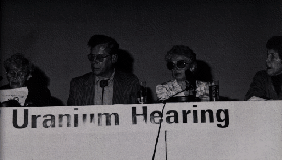 reprinted with permission from
reprinted with permission from
Poison Fire, Sacred Earth,
TESTIMONIES, LECTURES, CONCLUSIONS,
THE WORLD URANIUM HEARING, SALZBURG 1992
page 281
"The rate at which cancers, genetic damage, teratogenic malformation, infant deaths and other ill health are caused by radiation is much higher than was thought when nuclear industries were launched. We recommend immediate medical and social assistance for radiation victims."
Workshop Reports
Dose Limits And Epidemiology
Workshop Report by Prof. Wolfgang Köhnlein, Dr. Alice Stewart and Dr. Rosalie BertellProf W. Köhnlein, Fed Rep. of Germany. Scientist. -- Dr. R. Bertell, Ontario, Canada. Statistician at the Int. Inst. of Concern for Public Health, Toronto; Winner of the Alternative Nobel Prize (low-level radiation), nun.
Pr. W. K.: Good afternoon, Ladies and Gentlemen! We gathered a survey, the latest scientific literature on epidemiology and dose limits, and we found out that things have changed in the scientific knowledge and we have collected very short reports now which will be given by Rosalie Bertell and Alice Stewart.
Dr. A. S.: Regarding the health effects of low-level radiation, we have come to the following conclusions:
1. The situation is considerably more hazardous than was believed even three years ago.
2. Exposing more people to smaller doses, so-called dilution, will merely aggravate the problem, and it will aggravate the problem by adding to population loads of cancer and genetic damage.
3. Clean-up is impossible, since it merely means removing the position of indestructible matter.
4. Most important of all, that indigenous populations have not only benefited least from the industry, but have born far and away the heaviest load of damage.
We, therefore, recommend the following:
1. Immediate shut-down of all uranium mines.
2. Rapid phasing out of all other branches of the nuclear industry.
3. Meanwhile, occupational exposure to radiation should be a recognized occupational hazard with suitable compensation.
4. Unavoidable exposure to contaminated land should be similarly regarded with similar compensation. And this is important:
5. There should be no exceptions to anything that we have said so far in the name of national security or military necessity.
That closes what I have to say. Rosalie Bertell will enlarge on a few of these topics and we will give you the necessary references to the work that has been implied in the statements we have made. Thank you.
Dr. R. B.: These recommendations refer directly to the people at risk from the industries, so during the phase-out of nuclear power, which we have recommended, we ask that all unavoidable releases of radioactive materials be reduced to keep public exposures below one ten-thousandth of the current five-milliSievert-level per year. This would hold nuclear power to the same criterion as used for chemical industries, namely their pollution should cause no more than one cancer per 100,000 people over a lifetime. This is an interim limit prior to total phase out.
Secondly, the health problems perceived and reported here by the indigenous people, downwinders and others exposed to uranium and nuclear industries are strongly supported by medical scientific evidence. The rate at which cancers, genetic damage, teratogenic malformation, infant deaths and other ill health are caused by radiation is much higher than was thought when nuclear industries were launched. We recommend immediate medical and social assistance for radiation victims.
We also recommend that this finding be reported to the Permanent People's Tribunal and the United Nations Human Rights Commission as a serious violation of the human right to health and life.